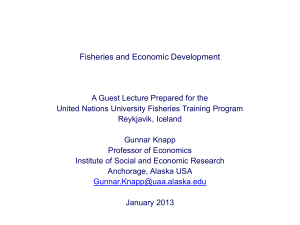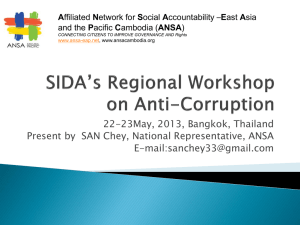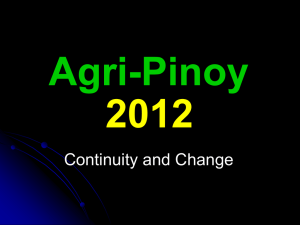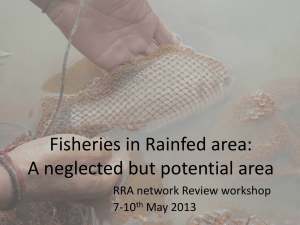Inland fishery sector: Issue and opportunities
advertisement
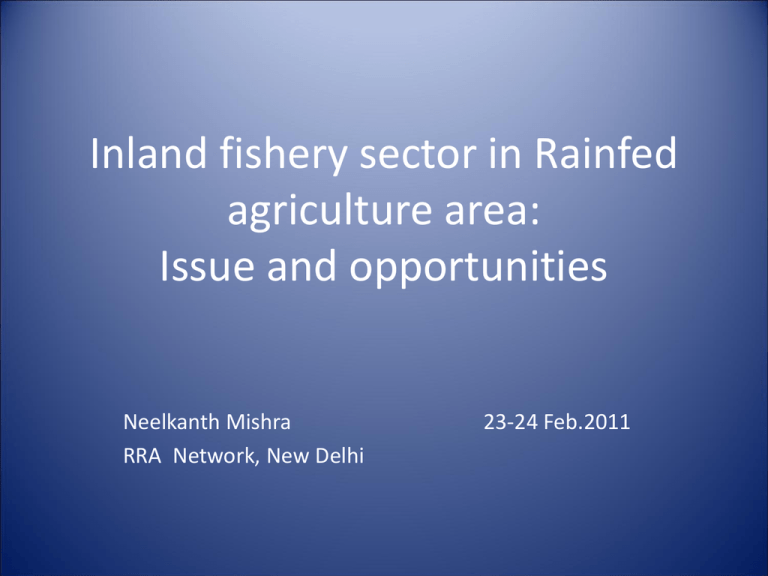
Inland fishery sector in Rainfed agriculture area: Issue and opportunities Neelkanth Mishra RRA Network, New Delhi 23-24 Feb.2011 India’s fishery sector: • The fisheries sector is a source of livelihood to about 14.48 million people • The total fish production is about 7.16 million tn, 4.19 million tn from inland and 2.97 million tn from marine fisheries. • In 11th V yr plan, Inland fishery sector is allocated 12% of total fishery sector budget and 4.25% of DAHD budget • Total GDP from this sector alone- more than Rs. 35000 Cr, 5.4 % of Agri sector GDP • 72% of workforce are women • Availability of quality fish seed is major issue. Presently, availability is only 13086 Fry /Ha ; deficit of 87000 /Ha Percentage share of fisheries sector in Indian agriculture 6 4.81 5 Percentage 5.34 5.33 4 4.87 4.70 3.37 3 2.17 2 1.46 1 (Source: DAHD&F, 2005; CSO, 2005) 20 04 -0 5 20 03 -0 4 20 02 -0 3 20 01 -0 2 20 00 -0 1 19 90 -9 1 19 80 -8 1 19 70 -7 1 0 Fish production in India : Production in RRA priority State (2008-09 in 000 Tn) Indian State Andhra pradesh Bihar Madhya pradesh Maharastra Odissa Rajasthan Chattishgarh Jharkhand Uttra pardesh West bengal 2008-09 Total 1252.78 300.65 68.65 523 349 25 158 75.82 349 1510 4611.9 Inland Fishery Resources of India Sl. No. States/U Ts Total 35 state and UT The 10 rainfed agri state holds Rivers & canals (km) 1,95,210 Reservoir s (million ha) Ponds & Tanks (million ha) 2.916 2.407 1.54( 62%) Source: Hand Book on Fisheries Statistics, 2005 Beels, Oxbow lakes & Derelict water bodies (million ha) 0.797 Brackish water (million ha) 1.24 Fish Seed Production Year 1973-74 Production (million fry) 1985-86 409 6,322 1990-91 10,332 1995-96 15,007 2000-01 15,608 2004-05 20,811 2008-09(p) 31497 * Presently, availability is 13086 Fry /Ha ; deficit of 87000 /Ha Central Budget priorities for fishery sector Scheme 11th plan BE 2007-08 BE 2008-09 Total DAHD 8174 910 1000 Total Fishery( CSS & CS) 2776 205.68 215 Total CS 1946 146.3 133 Total CSS 830 59.38 82 Inland fishery 350 9 12 Major issue : Inland fishery in Rainfed agriculture area • Access and control of traditional fishing community over production system • Access to technical support and regular capacity building to the fisher folk • Access to quality inputs in time to the communities like fingerlings, feed, etc • Access to basic infrastructure – such as Ice plants, cold storage facilities, market place, Vehicles for transport, landing centres, etc. • Involvement of women in the decision making process • Climate change and community preparedness to adopt the adverse situations /impacts through heavy rains/drought situations • How to improve the productivity and sustain it ??? • Accurate Data on resource, people and production • No policy priority( at National level and State level) • In sufficient budget availability and sector finance Opportunities • Andhra Pradesh, Madhya Pradesh, Uttar Pradesh, Bihar, Chattisgarh, Jharkhand, Maharastra, Orissa, West Bengal, Rajasthan are mostly depending on Inland fisheries sector . • This sector has potential to create livelihood and employment to more than 30 million people in the country. (thru’ value chain dev.) • Mostly unexplored area, closely associated with agri based production system • This sector has potential to develop community resilience due to climate change • Through MGNREGS the ponds, tanks and other water bodies can be developed for several activities like irrigation, to improve ground water level and fisheries. • Convergence with National Livelihood Mission Process to be Adopted: Enterprise and Market State level Dialogue Livelihood promotion Regional level Natural Resource development District level Intervention Community Mobilisation Local Government/ Local leadership Program Approach Advocacy Approach 11 Major stakeholder to be included: • • • • • Households and fishing communities Fishworker organizations Research organizations The State Civil society organizations (including NGOs, media, consumers and environmental organizations) • International organizations Best practices • • • • • • • • Fish seed rearing pilot with communities in Maharstra (Satara) Fish seed rearing, institution building, Rights over the resources, policy support (MP fisheries policy) and linkages, capacity building , productivity enhancement - Experiences of VIKALP, Bundelkhand region of Madhya Pradesh Convergence with several departments like Fisheries department, NFDB, NABARD, SERP, NGOs, CBOs, Tribal welfare department, MGNREGS Rural development department for inland fisheries development, Institution building, Establishing Fisheries Resource Centres (FRCs) , access to quality inputs, local marketing, developing infrastructure, community based management practices and linkages, capacity building , productivity enhancement - Experiences of WASSAN in APDAI project ( A project funded by World bank) in Andhra Pradesh Quality fish Seed production, fish seed rearing, technical support, capacity building , productivity enhancement - Experiences of GNNS-KVK in Telangana region of Andhra Pradesh Women fisherfolks organisation , (Odissa and Bihar) Private hatchery operators in Haryana and Panjab One aqua shop in Jharkhand Japan banks investment in Aasam and Arunachal pradesh Recommendations • • • • • • • • • Government of India have to come out with a “ National Inland Fisheries Policy” to provide support and strengthen inland fisheries sector and also suggest the states to state specific policies for Inland fisheries. Convergence with MGNREGS project for fisheries focused on tank development ( creating dead storage, bund strengthening, repairs etc) Establish “Fisheries Resource Centres” (FRCs) in Rainfed areas to provide technical support in the Inland fisheries sector Budget allocation for strengthening of existing institutions of fisher folk from the state and central budgets Facilitate National Fisheries Development Board (NFDB) to work with NGOs and other civil society organizations to strengthen Inland fisheries sector Make necessary changes in the existing policies to make women as members in the existing cooperatives & new bodies Make necessary budget allocation to access quality inputs to the communities like fingerlings, feed, etc Facilitate market development- Make necessary budget allocation to improve basic infrastructure – such as landing centers, Ice plants, market place, Vehicles for transport etc. Design, develop and support innovative approaches/programs to support landless, small and marginal farmers related to fisheries • As in the Madhya Pradesh policy, the traditional fishing communities and their cooperatives to be given all priority for leasing and licensing in inland capture and culture fisheries. • Increase lease period of water bodies for culture to 10 years as in Madhya Pradesh so that the lease holders feel more responsible to maintain the resources sustainably. • Measures to be taken to ensure to symmetrically collect and mange inland fish production data, including capture and culture of all species. This will help take better policy decisions. • Genuine inland fisher cooperative societies to be promoted, strengthened and necessary financial support given for taking up culture and capture fisheries. Policy intervention should aim at: • Guarantee access and control related rights of smallscale and indigenous fishing communities for their life and livelihood • Recognize, promote and protect the diversified livelihood base of fishing communities • Seek the free, prior and informed consent of smallscale fishing communities and indigenous peoples before undertaking activities that may affect their lives and livelihoods • Provide support to capacity-building of fishing and indigenous communities to participate in governance of coastal and fisheries resources • Women role in inland fisheries and fish marketing to be recognised and to insist 33% membership of women in newly formed cooperatives. • Create an enabling situation and promote fisheries co management in capture and capture cum culture fisheries. • Increase budgetary allocation for inland fishery program, and fishery dept should be made independent of cooperative and other dept. periphery. • Proper market development support, financial support and value chain development support needs to be provided. • More research and extension work on small and indigenous species(SIS) culture and its role in nutrition livelihoods to be strengthened including its auto stocking possibility of hatchery production. Thank You

